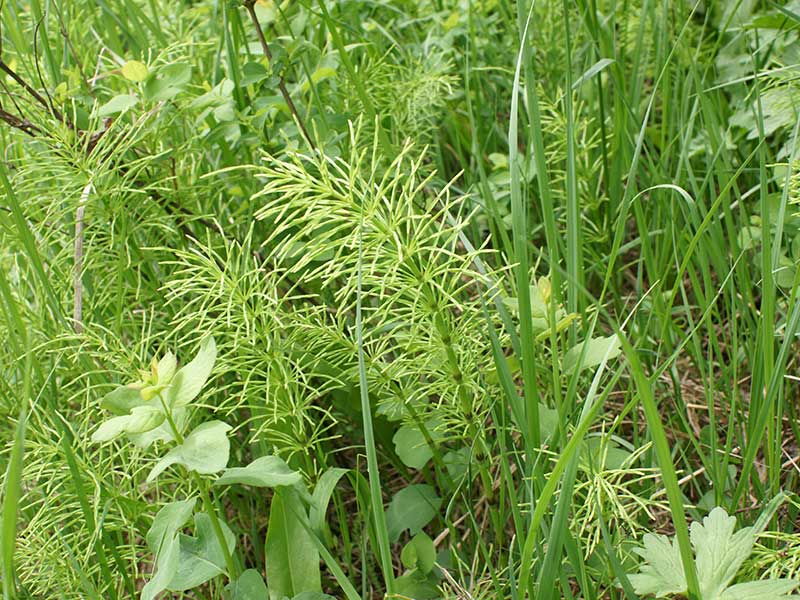Equisetum arvense / field horsetail
- segmented brown stems with spore-bearing “cone” at the tip
- or – segmented green stem with thin green branches radiating from nodes
- distinctly visible nodes along the stems
- no leaves or flowers
- found in many different habitats
See also: Equisetum hyemale / rough horsetail
Field horsetails basically look like brown or green sticks – up to 3 feet tall – with, in some parts of their phenology, whorls of needle-like branches radiating from nodes on their stems. Some stems may have as may as 20 nodes. Horsetails are perennial and spread clonally via rhizomes.
Field horsetail has separate, sterile non-reproductive stems and fertile spore-bearing ones. The fertile stems appear in early spring and are brown-ish, being non-photosynthetic. The stems release spores from single cone-like structures (strobilus/strobili) at their apices. The green, sterile stems appear later and persist longer. As seen in the gallery photos, it is sometimes possible to find both types at the same time in the spring.
Field horsetails have, in a sense, rhizomes on steroids. They can penetrate the soil to depths of up to 6 feet; they fork or branch freely, and bear tubers as additional storage reserves. As a result, the plants can tolerate a wide variety of conditions. For example, they can grow at temperatures as low as 40˚F and in areas receiving as little as 4″ of rain or as much as 80″ in a year.
Field horsetails are found throughout North America and much of the rest of the northern hemisphere. Typically, they are found in damp and open woodlands, but also in pastures, along roadsides, in disturbed areas or in riparian zones.
Interesting bits – Equisetums are sometimes called scouring rushes or horsetail ferns. Neither is correct. Rather, Equisetum is the single surviving genus of a class of plants dating back more than 350 million years. They are called “primitive”, not just because of their age, but because of the structure of their vascular and “root” systems. However, like ferns, they are non-flowering, and they reproduce by spores rather than seeds. Hence, they are called “fern allies”. Somewhere in all that evolutionary time, there have undoubtedly been multiple genome duplication events because now, field horsetail has 108 pairs of chromosomes (i.e. a diploid number of 216). This is bodaciously high.
Like many (if not all) grasses but unlike most herbs, field horsetail accumulates silicon. In general, this is hard on teeth so they are not easy to eat. However, they are used as a vegetable in Japan and Korea in the spring. The spring buds are apparently full of good things. Be careful, though, if eating is one of your activities. All other species of Equisetum are toxic, and even this species is toxic to stock, especially horses. So equus don’t etum.
Field horsetail is also an important component of the spring and early summer diets of black bears. I don’t know about grizzlies.
For what it’s worth, in polluted conditions, field horsetail is said to synthesize nicotine. Don’t try smoking them. And, because of the silicon, they have been used to polish pewter and wood. Rub lightly because they have also been used as an abrasive (think, sandpaper).
Perhaps most interestingly, field horsetail has been used by hurdy-gurdy players to dress the wheels of their instruments and remove resin build up. For a brief intro to this weird and wonderful instrument, look here, then follow up with some of the music links.
| Family | |
|---|---|
| When? | |
| Where? | disturbed, forest gaps and roadsides, moist meadows, riparian |



